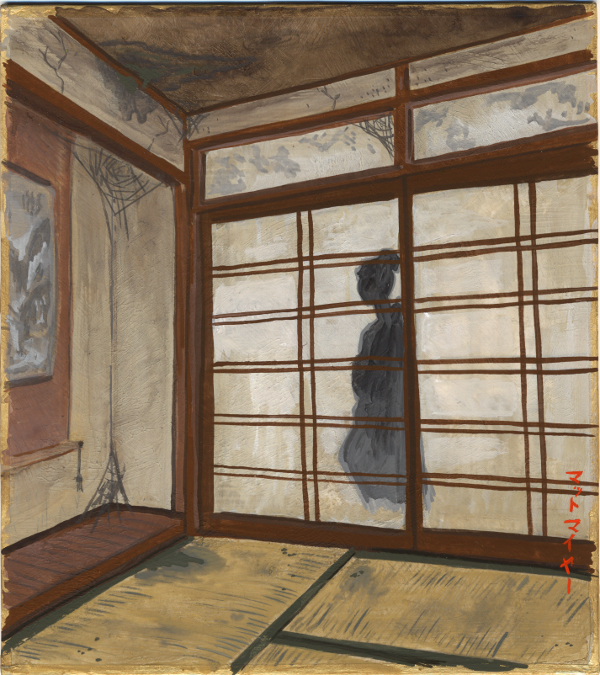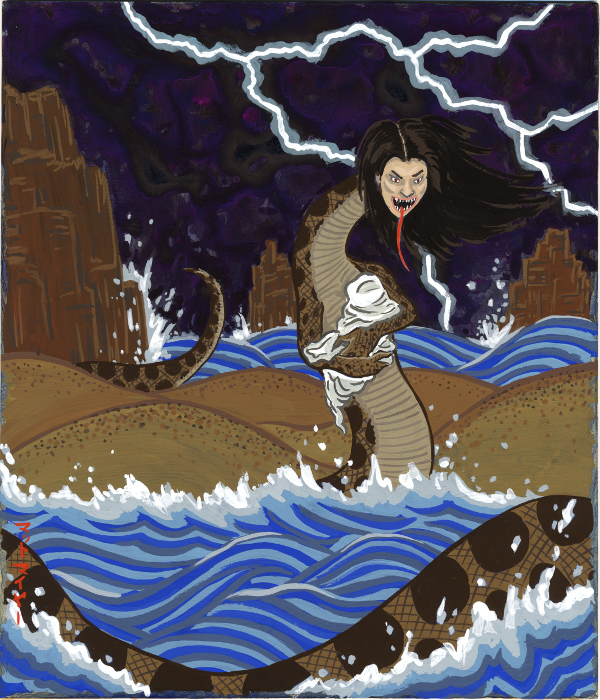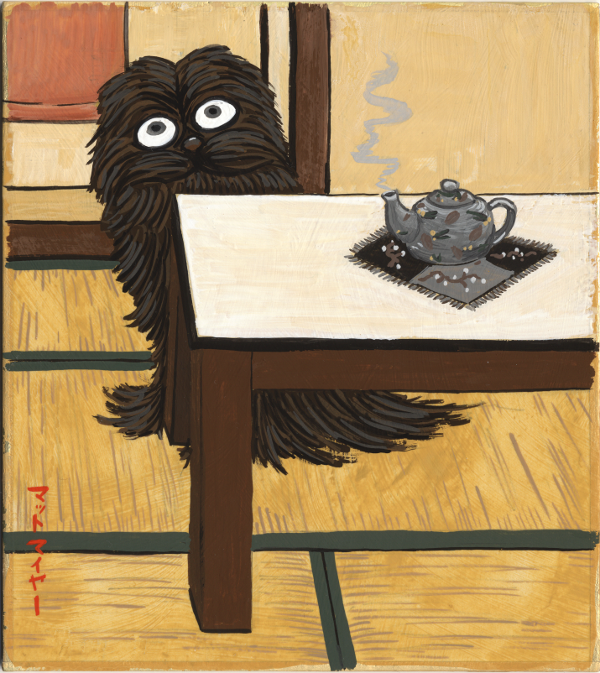Today’s yokai is not only awesome in its own right, but it is also the name of one of my favorite chain restaurants over here.
Tengu
This is one of the most famous and most interesting yokai, with a lot of documentation, and probably more paintings and imagery than all other the yokai combined. It is interesting for a number of reasons, the first being its name.
The name tengu is derived from the Chiense tiangou, a type of black dog that lives in the sky and eats the moon (during lunar eclipses). This brought about the Chinese superstition of beating dogs during an eclipse until the tiangou spits up and the moon returns to the sky. The characters for tengu, 天狗, literally mean “celestial dog,” and the writing is the same as it is in Chinese. Like many yokai we’ve looked at, the tengu was brought over to Japan from China along with Buddhism, Confucianism, government, writing, and many other things over 1000 years ago. And also like many of the yokai we’ve seen, the tengu quickly adapted into a completely unique Japanese being. For one, although it still retains the name, the tengu has no dog-like traits whatsoever, and does not swallow the moon. In fact, other than the name it bears no resemblance whatsoever to its Chinese namesake.
So what is a tengu exactly? Well, its been described as a god, a demon, and a kami, but mostly it is accepted as a yokai. Physically it appears in a few common forms: one is that of an anthropomorphic kite-like monster (kite the bird, not the toy); another is a human yamabushi, a Japanese ascetic mountain warrior-sage; and a third is a hybrid of the previous two, usually with an enormous nose that would make even Cyrano de Bergerac blush, and a deep red face. The tengu is extremely wise, extremely powerful, and extremely dangerous. They enjoy eating humans, and they are fierce enemies of Buddhism. There are many stories of tengu carrying off monks into the mountains to be ravaged and devoured. They mislead the pious with false images of Buddha, impersonate women and try to seduce holy men, they rob temples, and they can also grant great unholy power to evil men who would worship them. They often abduct young boys and drop them in the woods, or tie them to the tops of trees, or forcing them eat feces until they go mad. There are dozens upon dozens of tales of tengus doing harm to mankind. Even the Japanese Emperor Sutoku, in the 12th century, is said to have died in torment and sworn to haunt the country forever as a great demon, and so his ghost transformed into a vicious tengu. But don’t worry — according to local lore from Ishikawa prefecture, tengu hate mackerel, so if you hang the fish up around your house, you may just be able to keep yourself safe!
So how is a tengu born exactly? Well, in most cases they are the ghosts of bad men and women whose souls cannot go to Heaven, but as Buddhists also cannot go to Hell. Often people with excessive pride become tengu after death. It is said that wise and knowledgeable men become very powerful daitengu, while ignorant people turn into the weaker kotengu. Being an important enemy of Buddhism, the priests did a lot of work to document them, and there are even a number of famous named tengu, as well as locations which are specifically infested with tengu. One of these books is the Tengu Meigiko, which documents the 17 best-known daitengu and the mountains that each one calls home. These daitengu often take on the more human-like, long-nosed appearance, while the kotengu are often more monstrous and bird-like.
But not all tengu are bad! There are, in fact, a number of good tengu written down in Buddhist parables. And in the last 300 years or so, the horrific image of tengu has given way to more stories of good — or at least neutral — tengu. Tengu eventually evolved into the vigilant protectors of mountains and forests, and they inflict terrible punishments on foolish mortals who would so much as pick a single leaf from their protected grounds. As they are often described as yamabushi, or shugenja, there have even been a number of religious cults that worship tengu as kami. Tengu are also well-known for being martial arts masters, and there are many legends of people seeking tengu out for training. These legends were popularized by later Japanese painters and printers, as well as playwrights and dramatists.
Tengu are extremely popular even today, and if you’ve even spent only one day in Japan you’ve likely seen at the very least a wooden mask with a long red nose, or a painting of a tengu on a freight truck, or a restaurant with tengu masks or sculptures. They are everywhere, a testament to their popularity and versatility as heroes and villains, monsters and masters.

Tengu
Don’t forget that you can buy prints from the A-Yokai-A-Day project from my Etsy store. They make great Halloween gifts, and look incredibly stylish in any room of the house. (They also make great conversation pieces!) Originals are also available; please email me for details! | 「今日の妖怪シリーズ」今日は天狗です。
天狗は、最も有名で興味深い妖怪のうちの一つであり、他の妖怪に比べると多くの絵画やイラストが見られます。
私が天狗に興味を興味を抱いた理由の一つがその名前です。天狗の名は中国でtianguと呼ばれていたものが伝わったもので、空に住み月を食べる(月食の時)黒い犬をさします。中国には、tianguが月を食べてから吐き出すまでの間(月食の間)にまつわるたくさんの言い伝えがあります。
「天狗」の名前の意味は、”天の狗(いぬ)”で、中国語でも「天狗」の漢字が使われています。多くの妖怪達と同様に、天狗についても仏教,儒教,政治,書字などとともに1000年以上前に中国から伝わったもののようです。
そしてこれまた他の妖怪達と同様に、天狗は日本に伝わるとすぐに日本特有のものに変わっていったようです。実際に、日本で伝えられている天狗は、「天狗」という名前こそ同じですが狗の形をしておらず月も食べませんので、名前以外に類似する所はないといえます。
では、「天狗」とはいったい何なのでしょう?神であったりdemon(デーモン)であったりしますが、多くは妖怪として語られているようです。
天狗にはさまざまな種類がありますが、いくつかのよく見られる特徴を紹介しましょう。
1つは、擬人化された鳥のような形。2つ目は人の山伏(やまぶし)に似た形。3つ目は上の二つよりも驚く特徴で、非常に長い鼻がある形です。
天狗は膨大な知識を持ち、非常に強力で危険です。彼らは人間を食べることを楽しみます。そして仏教を妨げる者とされています。
天狗にまつわる話はたくさんあり、それは修行僧を襲ったり、子供を木の上に落としたり木に縛り付けたりと様々です。中でもこんなエピソードがあります。第75代天皇である崇徳上皇は、保元の乱に敗れた後讃岐の国に流されました。そこで彼は自らの血で大乗経を書き、「この写経の功力を三悪道に投げ込み、その力をもって日本国の大魔縁とならん」と言って舌を噛み切ってその血でさらに呪詛をしたというものです。その後彼は生きたまま天狗になったと言われています。
こわい話がありましたが、石川県に伝わっている話によると、天狗は鯖が嫌いなようです。家の周りに魚を吊るしておけば、安全に生活できるでしょうから安心してください。
さて、天狗はいったいいつ生まれたのでしょうか?多くの場合、天狗は天国にいけなかった悪い人間のゴーストであるとされています。しばしば強すぎるプライドを持っている人は、死後天狗になるとされているようです。賢明で博識な人は大天狗になり、無知は人はより弱い小天狗になるとされています。
天狗は仏教にとって大きな敵でありましたので、仏教徒たちは天狗に関する沢山の記録を作りました。そしてそれは今残っている多くの有名な天狗の名称になっています。その中の一つの本Tengu Meigikoで、そこには17種類の良く知られている大天狗と、彼らの家である山について書かれています。大天狗はより人間に近く、長い鼻を持っており、小天狗はよりモンスターのようか鳥のようであるとされています。
しかし、全ての天狗が悪い天狗ではありません。多くの良い天狗についても、仏教徒の書物に書かれています。300年ほどの間で、怖いイメージの天狗は良いかもしくはニュートラルなイメージにかわっていきました。彼らは山を守る存在であり、守護している山から葉っぱを摘みすぎているものに罰を与えるなどしています。天狗の姿がしばしば山伏や修行者として記述されているように、神として天狗を崇拝している多くの話もあります。また、天狗はブドウの達人であるとも知られており、天狗を探すためトレーニングする話もあります。これらの多くの伝説は、画家や劇作家などによって普及されてきました。
大変昔から伝わっている天狗ですが、現代でもとても人気があります。もし日本に1日だけでも滞在するときがあったら、きっと鼻の長い赤い天狗の顔を、お面かトラックの側面、レストランなどで見つけることができるでしょう。
天狗は本当にいたるところで見ることができます。それは英雄であたり悪者であったり怪物であったり達人であったりと多才で有名な証拠でしょう。

天狗
私のEtsy storeのチェックを忘れずに!販売が可能になっていますよ!








